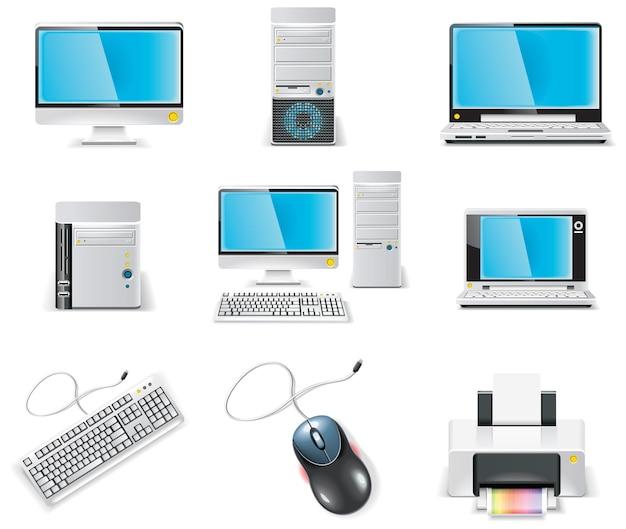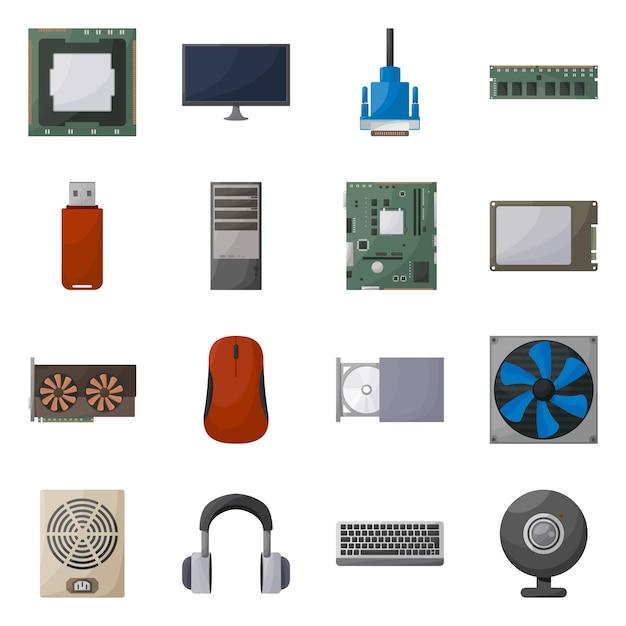Welcome to the wonderful world of computers! In today’s fast-paced digital age, computers play an indispensable role in our lives. From smartphones and laptops to powerful servers, these incredible machines are everywhere, making our lives easier and more connected than ever before.
But have you ever wondered about the different types of computers that exist? In this blog post, we’ll be diving deep into the fascinating world of technology to explore the ten types of computers that dominate our modern world. Whether you’re a tech-savvy individual or just curious about the devices you use every day, this article aims to provide insight into the diverse range of computers that surround us.
So, if you ever wondered what distinguishes a desktop computer from a mainframe or what makes a supercomputer so, well, super, then this is the blog post for you. We’ll explore the variety of computers out there, discuss their classifications, and delve into how they shape our daily lives in more ways than we may realize. Get ready to embark on a journey through the exciting realm of modern technology!

Types of Computers: A Fun and Informative Guide
Are you ready to embark on a journey through the fascinating world of computers? Strap in as we explore the ten different types of computers that exist in our modern age. From the mighty supercomputers to the portable tablets, there’s a computer out there for every need and preference. So without further ado, let’s dive right into it!
1. Supercomputers: The Titans of Computing Power
Imagine a superhero with astounding computational abilities – that’s a supercomputer! These behemoths are built to handle complex calculations and process massive amounts of data at incredible speeds. Want to unravel the mysteries of the universe or simulate a nuclear explosion? Supercomputers are your best bet.
2. Mainframe Computers: The Grandmasters of Data Processing
When it comes to processing and storing vast amounts of data for large organizations, mainframe computers take the crown. They are like the wise old sages, meticulously handling critical transactions and providing immense computing power to keep businesses running smoothly.
3. Mini Computers: Small but Mighty
Don’t let their name fool you, mini computers are no pushovers. While they may not have the muscle power of supercomputers or mainframes, they pack quite a punch for their size. Mini computers are perfect for tasks that require moderate computing prowess, making them a popular choice for small to medium-sized businesses.
4. Microcomputers: The Revolution Starts Here
Ah, microcomputers, the trailblazers of personal computing. These are the computers you’ll find in most households, ranging from desktops to laptops. They have become an integral part of our lives, empowering us to connect with the world, binge-watch our favorite shows, or even write a funny blog post like this one!
5. Workstations: More Power, More Productivity
Think of workstations as the overachievers of the computing world. They are specifically designed for high-performance tasks like computer-aided design (CAD), graphic design, and video editing. With their top-notch processing capabilities and advanced graphical prowess, workstations supercharge your productivity.
6. Servers: The Silent Helpers
You may not see them, but servers are the unsung heroes of the internet. From hosting websites to managing data storage and email services, servers silently work in the background, ensuring all your online activities run smoothly. So the next time you browse the web, give a nod to these quiet warriors.
7. Embedded Computers: The Hidden Wonders
Ever wondered where computers are secretly lurking? They’re hiding in plain sight as embedded computers! Found in everyday objects like cars, appliances, and even toys, embedded computers perform specific tasks and make our lives easier without us even realizing it. It’s like having a technological fairy godmother!
8. Personal Digital Assistants: Your On-the-Go Sidekicks
If you’ve ever dreamt of having a personal assistant at your beck and call, personal digital assistants (PDAs) come pretty close. These handheld devices tackle your daily organizational needs, from managing your calendar and contacts to giving you a boost of confidence with voice-controlled virtual assistants.
9. Tablets: The Best of Both Worlds
Tablets bring together the convenience of a smartphone and the versatility of a laptop, making them a popular choice for work and play. With their sleek designs, touchscreens, and portable nature, tablets offer a delightful blend of entertainment and productivity, ensuring you have fun while getting things done.
10. Wearable Computers: Technology on Your Sleeve
They say fashion is a statement, so why not make a statement with wearable computers? From smartwatches that keep you connected on the go to smart glasses that bring augmented reality to life, wearable computers take technology out of our pockets and place it literally on our sleeves (or wrists).
Now that you’ve journeyed through the ten types of computers, you’re armed with the knowledge to impress your friends at your next tech-related gathering. So go forth, embrace the power of computers, and remember to always have fun in this ever-evolving digital realm!
Note: The information provided is up-to-date as of 2023.

FAQ: What You Need to Know About the 10 Types of Computers
Introduction: Welcome! Today, we’re diving deep into the fascinating world of computers. Have you ever wondered what exactly a computer is, or maybe what types of computers are out there? Well, you’ve come to the right place. In this FAQ-style guide, we’ll answer all your burning questions about computer diagrams, classifications, and different types of computers. So, let’s get this tech party started!
What is a Computer Diagram
A computer diagram is like a visual map that showcases the components and connections within a computer system. It offers a simplified representation of how everything functions together, allowing us to better understand the inner workings of these complex machines.
What Are the 10 Types of Computers
-
Personal Computers (PCs): These are the computers you’ll find in most households or offices. They come in various forms, such as desktops, laptops, and all-in-ones.
-
Workstations: Designed for professionals requiring high-performance capabilities, workstations are ideal for tasks like video editing, 3D modeling, and scientific simulations.
-
Mainframes: Picture a giant computer filling up a whole room. That’s a mainframe! Mainframes are critically powerful machines often used by large organizations and government entities to handle mass amounts of data.
-
Supercomputers: One step beyond mainframes lies the realm of supercomputers. These beasts are all about absolute power, capable of solving complex scientific problems, forecasting weather patterns, and more.
-
Embedded Computers: Have you ever heard of the “Internet of Things”? Embedded computers are what make it possible. They’re the tiny computers hiding in everyday objects, making them smart – think smart fridges, smartwatches, and even smart toothbrushes!
-
Mobile Devices: We all know and love our smartphones and tablets. These sleek gadgets are essentially pocket-sized computers, allowing us to browse the internet, play games, and stay connected on the go.
-
Servers: When multiple computers need to share resources in a network, servers come into play. They handle tasks like storing data, managing emails, and hosting websites.
-
Mini Computers: Falling between mainframes and personal computers in terms of size and power, mini computers cater to small businesses, serving as robust solutions for their computing needs.
-
Microcomputers: Don’t let the name fool you – microcomputers can still pack a punch! They include devices like single-board computers and microcontrollers, often used for education, hobby projects, or building prototypes.
-
Wearable Computers: Brace yourself for the future – wearable computers are here! From smart glasses to fitness trackers, these devices integrate technology into our clothes and accessories, enhancing our lives through connectivity and convenience.
What is a Computer in Simple Words
In simple terms, a computer is a clever machine that takes input, performs calculations or processes, and then produces output. It’s like having your very own smart assistant who can execute tasks according to your commands.
What Are the 2 Classifications of Computer Devices
Computers can be classified based on their size and purpose:
-
General-Purpose Computers: These are versatile machines that can perform a wide range of tasks. Personal computers and laptops fall into this category.
-
Special-Purpose Computers: As the name suggests, special-purpose computers are designed for specific applications, such as supercomputers used for complex calculations or embedded computers dedicated to a particular function, like controlling traffic lights.
What Are the 4 Types of Computers
In terms of computer architecture, we have four main types:
-
Analog Computers: These computers work with continuous data and are often used in scientific and engineering fields to solve mathematical equations.
-
Digital Computers: The most common type today, digital computers process information in discrete chunks, represented by 0s and 1s.
-
Hybrid Computers: As the name implies, hybrid computers combine the best of analog and digital worlds, allowing for precise calculations alongside the ability to process vast amounts of data.
-
Quantum Computers: Quantum computers harness the mind-boggling principles of quantum physics to perform calculations at phenomenal speeds. While still in their early stages, they offer exciting possibilities for solving complex problems.
How Are Computers Useful in Daily Life
Computers have become an integral part of our daily lives, here are just a few ways they impact us:
-
Communication: From sending emails and video calls to social media and messaging apps, computers keep us connected across the globe.
-
Education: Computers are transforming education, making learning more engaging and accessible through online courses, interactive study materials, and virtual classrooms.
-
Entertainment: Whether it’s watching movies, playing games, or streaming music, computers provide endless entertainment options.
-
Work: Computers enable us to be more productive, allowing for tasks like document editing, data analysis, and project management – improving efficiency in the workplace.
How Are Computers Classified
Computers can be classified based on various factors, such as their size, purpose, architecture, and processing abilities. The most common classifications include personal computers, mainframes, supercomputers, and mobile devices.
What Is a Modern Computer
In 2023, a modern computer refers to the latest generation of devices we commonly use, including powerful desktops, lightweight laptops, versatile tablets, and sleek smartphones. These devices boast impressive processing power and advanced features, thanks to continuous advancements in technology.
That’s a wrap folks! We hope this FAQ-style guide has given you a better understanding of computer diagrams, the different types of computers, and how these machines shape our daily lives. Computers have truly revolutionized the way we work, connect, and have fun. So, the next time you’re tapping away on your smartphone or firing up your trusty laptop, remember the incredible journey these machines have taken us on. Stay tech-savvy, stay curious!
